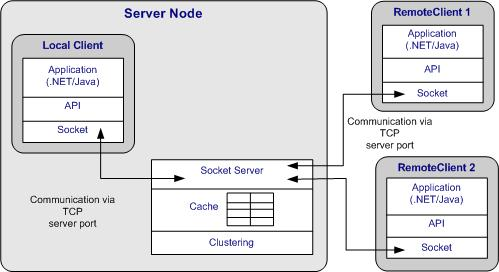| < Previous page | Next page > |
Overview
You can decide whether to run client applications on server nodes (nodes which are participating in cache cluster) or access cache remotely. In case of remote client access, you have to install NCache on remote node and your application will use same API to access cache remotely.
Bare sockets are used for client server communication due to which no dependency on metadata exists. Moreover, there is no extra serialization/deserialization expense. Because of bare sockets, any application other than .Net can also communicate with server. You can specify port for NCache Server, for client server communication, in Alachisoft.NCache.Service.exe.config file.

Client requests are validated by the server and then forwarded to the cache for further processing. Similarly, results from cache are sent back to client application. Every client trying to use cache connects to server via NCache Client API. When client initializes cache, it gets connected to NCache server. NCache server associates the specified cache instance with client connection and any further requests by that client are routed to that specific cache only i.e. NCache server can maintain state. It also means, a single client application can have more than one connection with NCache Server each associated with different cache instance, thus multiple cache instances per application.
When .Net client resides on server node, it can access cache either in InProc or OutProc. However, Java client accesses cache as Outproc, locally.
Both .NET and Java clients can access cache across the network seamlessly. Client API for local and remote clients is same. Remote clients also have failover capability. If their connected server goes down, clients will be automatically connected to the next server in the list. List is dynamically updated at run time as new servers join the cluster.
See Also
|